Coat of arms of Croatia
The coat of arms of the Republic of Croatia (Croatian: Grb Republike Hrvatske) consists of one main shield and five smaller shields which form a crown over the main shield. The main coat of arms is a checkerboard (chequy) that consists of 13 red and 12 white fields. It is also informally known in Croatian as šahovnica ("chessboard", from šah, "chess"). The five smaller shields represent five different historical regions within Croatia.
| Coat of arms of Croatia | |
|---|---|
 | |
| Armiger | Republic of Croatia |
| Adopted | 21 December 1990 |
| Crest | A crown of five arms, as follows: Azure a mullet of six points Or above a crescent argent; Azure two bars gules; Azure three leopard heads caboshed Or; Azure a goat statant Or unguled and armed gules; Azure on a fess gules fimbriated argent a marten Sable courant proper in chief a mullet of six points Or |
| Blazon | Chequy gules and argent |
Official description
Croatian law describes the coat of arms as follows:[1]
The coat of arms of the Republic of Croatia is the historical Croatian coat of arms in the form of a shield twice divided horizontally and vertically into twenty-five red and white (silver) fields, so that the first field in the upper left corner is red. Above the shield lies a crown with five spikes, slightly arched with its ends conjoined with upper left and right parts of the shield. Within the crown, five lesser shields with historical Croatian coats of arms, lined from left to right in the following order: the oldest known Croatian coat of arms, coats of arms of the Dubrovnik Republic, Dalmatia, Istria and Slavonia. The ratio of height of the field of the main shield to the height of the smaller shields in the crown is 1:2.5, and of the width of the field of the main shield to the width of the smaller shields in the crown is 1:1. The oldest known coat of arms of Croatia contains in a shield on a light blue field a yellow (golden) six-pointed star with a white (silver) crescent. Coat of arms of the Republic of Dubrovnik contains in a shield on a blue field two red bars. The Dalmatian arms contain in a shield on a light blue field three yellow (golden) crowned leopard heads. The Istrian arms contain in a shield on a blue field a yellow (golden) goat facing left with red hooves and horns. The Slavonian arms contain on a light blue field two horizontal white (silver) bars, between bars a red field, on which sneaks a weasel to the left. In the upper light blue field is a yellow (golden) six-pointed star. The coat of arms is lined red.
History
The checkerboard coat of arms (šahovnica) is first attested as an official symbol of the Kingdom of Croatia on an Innsbruck tower depicting the emblem of Maximilian I, Archduke of Austria in 1495.[2][3] It appeared on a seal from the Cetingrad Charter that confirmed the 1527 election of Ferdinand I, Archduke of Austria as king of Croatia in Cetin.[3][4][5] Under the Hungarian kings and well after the Council of Constance, as shown in the works of Ulrich of Richenthal and Conrad Grünenberg, the Croatian coat of arms was an arm dexter holding a dagger (possibly alluding to Miloš Obilić).
The origin of the design has often been purported as being medieval. Historic tradition states it to be the arms of Stephen Držislav in the 10th century.[6] A Split stone baptistry from the time of Peter Krešimir IV (r. 1058–1074/5) has engraved falcons that carry something that resembles a chequy on their wings, and the bell tower of the medieval Church of St. Lucy, Jurandvor has a checkerboard pattern carved onto it.[7]
The size of the checkerboard ranges from 3×3 to 8×8,[8] but most commonly 5×5, like in the current design. It was traditionally conjectured that the colours originally represented Red Croatia and White Croatia, but there is no historical evidence to support this.
Towards the Late Middle Ages the distinction for the three crown lands (Croatia proper, Dalmatia, Slavonia) was made. The šahovnica was used as the coat of arms of Croatia proper & together with the shields of Slavonia and Dalmatia was often used to represent the whole of Croatia in Austria-Hungary. It was used as an unofficial coat of arms of the Kingdom of Croatia adopted in 1848 and as an official coat of arms of the post-1868 Kingdom of Croatia-Slavonia (both unofficially known as Triune Kingdom). The two are the same except for the position of the šahovnica and Dalmatian coat of arms which are switched around & with different crowns used above the shield – the later employing St Stephen's crown (associated with Hungarian kings).
By late 19th century šahovnica had come to be considered a generally recognized symbol for Croats and Croatia and in 1919, it was included in the coat of arms of the Kingdom of Serbs, Croats and Slovenes (later the Kingdom of Yugoslavia) to represent Croats. When the Banovina of Croatia was formed, the šahovnica (chequy gules and argent) was retained as the official symbol.
The Ustashe regime which had ruled Croatia during the World War II superimposed their ideological symbol, the letter "U" above or around the šahovnica (upper left square white) as the official national symbol during their rule.
After the Second World War, the new Socialist Republic of Croatia became a part of the federal Second Yugoslavia. The šahovnica was included in the new socialist coat of arms.[9] It was designed in the socialist tradition, including symbols like wheat for peasants and an anvil for workers, as well as a rising sun to symbolize a new morning and a red star for communism.
During the change to multiparty elections in Croatia (as part of the collapse of Communist rule in Eastern Europe from the late 1980s), and prior to the establishment of the current design, the šahovnica, shedding the communist symbols that were the hallmark of Croatia in the second Yugoslavia, reappeared as a stand-alone symbol as both the 'upper left square red' and 'upper left square white' variants. The choice of 'upper left square red' or 'upper left square white' was often dictated by heraldic laws and aesthetic requirements.
The first-field-white variant was adopted by the Republic of Croatia and used briefly in 1990.[10] According to constitutional changes which came into effect on 26 June 1990 the red star in the flag of SR Croatia was to be replaced by the "historical Croatian coat of arms with 25 red and white fields", without specifying order of fields.[11] The first-field-white variant was used at the official flag hoisting ceremony on 25 July and was later occasionally used on par with the first-field-red variant until 21 December 1990 when the current coat of arms was officially adopted.[11][12]
Current design
On 21 December 1990, the post-socialist government of Croatia, passed a law prescribing the design created by the graphic designer Miroslav Šutej, under the aegis of a commission chaired by Nikša Stančić, then head of the Department of Croatian History at the Faculty of Philosophy, University of Zagreb.
The new design added the five crowning shields which represent the regions of Croatia. They are, from left to right:
 |
Considered the oldest known symbol representing Croatia:[13][14] Bleu celeste, a mullet of six points Or surmounted above a crescent Argent – A golden six-pointed star (representing the morning star) over a silver crescent moon on a blue shield. The oldest known example is found on the obverse side of the Croatian Frizatiks minted by Andrew II as Duke of Croatia (Latin: Dux Croatiae).[15][16][17] Traditionally this coat of arms was depicted on red (gules) background such as the flag of the Triune Kingdom by Josip Jelačić. This coat of arms was also commonly associated with the Illyrian movement. |
 |
Dubrovnik region – Coat of arms of Dubrovnik: Azure, two bars gules – Two red stripes on a dark blue shield. This is a simplified variation of the Coat of arms of Dubrovnik, with two red bars instead of four; it was used by Dubrovnik Republic since the 14th century. The original coat of arms is the old coat of arms of Árpád dynasty, granted to Dubrovnik Republic by King Louis I in 1358 as it became a vassal of the Hungarian-Croatian king.[18][19][20][21][22] The red-blue variant hails from the 1950s interpretation of the template (decorative) lines within the originally white lines of the original CoA.[23][24] |
 |
Dalmatia – Coat of arms of Dalmatia: Bleu celeste, three leopards' heads affrontés caboshed Or, crowned Or – Three golden, crowned heraldic leopard heads, two over one, on a blue shield. The depicted version from the crown differs from the traditional depiction of these arms: traditionally, the leopards are roaring and langued (i.e. with tongues visible), and the colour of the shield is heraldic azure, not bleu celeste. Historically, this coat of arms was in use since at least the 14th century. The first officially recorded use goes back to King Louis I and his daughter Queen Mary who both used an earlier version of the arms as part of their personal coat of arms. Until 1526 this coat of arms was also used to represent Croatia in general,[25] apparent from the coat of arms of several kings: Louis I, Mary, Matthias Corvinus and Louis II. It is also found on the great seals of Sigismund of Luxembourg,[26] Albert II,[27] John Zápolya,[28] Ferdinand I,[29] and from then on various seals and arms of the Habsburgs. Originally the coat of arms was three lion heads on red background, turned to left.[30][31][32][33][34] |
-vector.svg.png.webp) |
Istria – Coat of arms of Istria: Azure, a goat (capricorn) statant Or, attired and hoofed Gules – Golden goat (capricorn) with red hooves and horns, on a dark blue shield. The goat as a symbol of Istria is claimed to be associated with Istria since ancient times.[35][36] However the origins of this coat of arms are unclear and until the 19th century there was no official symbol of Istria.[37] The first depictions are found on the maps of Johann Weikhard von Valvasor in the 17th century and later in Stemmatographia sive armorum Illyricorum delineatio, descriptio et restitutio (1701) by Pavao Ritter Vitezović.[37][38] It was only in 1861 when the March of Istria became the Crown land in the Austrian Empire that this coat of arms became official.[37] Traditional depictions of the arms differed greatly depending on the authors: mostly depicted on a blue but sometimes also on green background, colors (tinctures) of the charge (goat – sometimes with gold and sometimes with red hooves and horns), position or attitude of the goat – sometimes shown as passant (passing with front leg up) and sometimes statant (standing with all four legs on the ground), orientation of the charge – sometimes turned to right and sometimes to left (dexter and sinister) and even the charge itself with some variants showing a female goat and some a Capricorn (male goat).[39][40] The current variant used in the crest and also as the coat of arms of County of Istria are both derived from the March of Istria arms from 1861 by Hugo Gerard Ströhl. |
 |
Slavonia – Coat of arms of Slavonia: Bleu celeste, a fess Gules fimbriated Argent surmounted by a mullet of six points Or, a marten Sable courant proper in chief – Six-pointed star (morning star) above two silver stripes on a blue shield (representing the rivers Drava and Sava marking the Northern and Southern border of Slavonia), between them a running Pine marten in natural colors (Kuna in Croatian – note the national currency Croatian kuna) on a red field. Historically correct version of the arms uses a heraldic blue rather than light blue (Bleu celeste). This coat of arms was derived from an earlier version found on Slavonian Banovac coins minted between 1235 and 1384,[25] which showed a marten running on a field between two six-pointed stars.[15][17][41] The coat of arms was officially granted by king Vladislaus II Jagiellon on December 8, 1496.[25][42] It was used as the official seal of Croatian Sabor from 1497 until the late 18th century.[25][43] |
Some of the more traditional heraldic pundits have criticized the latest design for various design solutions, such as adding a crown to the coat, varying shades of blue in its even fields, and adding the red border around the coat. The government has accepted their criticism insofar as not accepting further non-traditional designs for the county coats of arms, but the national symbol has remained intact.
Unlike in many countries, Croatian design more commonly uses symbolism from the coat of arms, rather than from the Croatian flag. This is partly due to the geometric design of the shield which makes it appropriate for use in many graphic contexts (e.g. the insignia of Croatia Airlines or the design of the shirt for the Croatia national football team), and partly because the Pan-Slavic colors are present in many European flags.
Historical versions of the crown arms
Most coats of arms used in the crown on the modern-day coat of arms differ slightly from historically accurate versions.
 "Illyrian" coat of arms
"Illyrian" coat of arms
(considered oldest known symbol of Croatia)
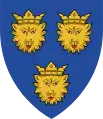
 Coat of arms of Istria
Coat of arms of Istria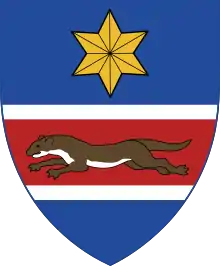 Coat of arms of Kingdom of Slavonia
Coat of arms of Kingdom of Slavonia
Gallery
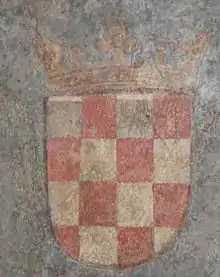
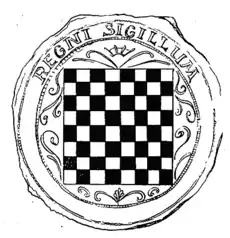 Coat of arms of Croatia used in 1527 as part of a seal on the Cetingrad Charter
Coat of arms of Croatia used in 1527 as part of a seal on the Cetingrad Charter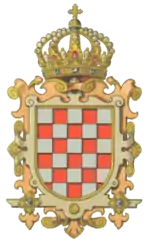 Kingdom of Croatia (1525–1868)
Kingdom of Croatia (1525–1868) Coat of arms of Croatian Crown land (until 1868)
Coat of arms of Croatian Crown land (until 1868)_(1868-1918).svg.png.webp) Kingdom of Croatia-Slavonia (1868–1918). The official version had St. Stephen's crown due to Croatia being part of Lands of the Crown of Saint Stephen.
Kingdom of Croatia-Slavonia (1868–1918). The official version had St. Stephen's crown due to Croatia being part of Lands of the Crown of Saint Stephen..svg.png.webp) Coat of arms of Transleithania (1868–1915)
Coat of arms of Transleithania (1868–1915) Patriotic badge from 1914
Patriotic badge from 1914.svg.png.webp) Lesser Coat of arms of Transleithania (1915–1918)
Lesser Coat of arms of Transleithania (1915–1918) Common coat of arms of Austria-Hungary (1915–1918)
Common coat of arms of Austria-Hungary (1915–1918).png.webp) Austria-Hungary, lesser version (1916–1918)
Austria-Hungary, lesser version (1916–1918).svg.png.webp) Coat of arms of Croatia (State of Slovenes, Croats and Serbs period)
Coat of arms of Croatia (State of Slovenes, Croats and Serbs period)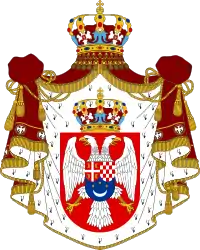 Kingdom of Yugoslavia (1918–1943)
Kingdom of Yugoslavia (1918–1943) Banovina of Croatia (1939–1943)
Banovina of Croatia (1939–1943) Banovina of Croatia greater version (1939–1943)
Banovina of Croatia greater version (1939–1943) Independent State of Croatia (1941–1945)
Independent State of Croatia (1941–1945)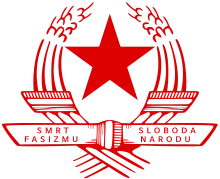 ZAVNOH & Federal State of Croatia (1943)
ZAVNOH & Federal State of Croatia (1943) ZAVNOH & Federal State of Croatia (1943–1947)
ZAVNOH & Federal State of Croatia (1943–1947)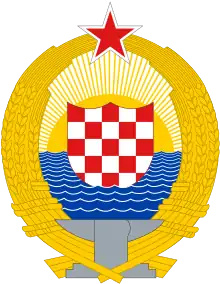 Socialist Republic of Croatia (1947–1990)
Socialist Republic of Croatia (1947–1990).svg.png.webp) Early coat of arms of the Republic of Croatia (1990)
Early coat of arms of the Republic of Croatia (1990)
See also
References
- Zakon o grbu, zastavi i himni Republike Hrvatske te zastavi i lenti predsjednika Republike Hrvatske, Članak 7
- Karl-Heinz Hesmer: Chronik griffbereit: Flaggen und Wappen der Welt. Wissen Media Verlag GmbH, 2008. ISBN 978-3-577-14537-4.
- Ottfried Neubecker: Wappen – ihr Ursprung, Sinn und Wert, ISBN 3-8105-1306-7
- Robert Stallaerts: Historical dictionary of Croatia. Scarecrow Press, Inc. 2010. ISBN 978-0-8108-6750-5
- Robert Layton, Julian Thomas, Peter G. Stone: Destruction and conservation of cultural property. Routledge, 2001. ISBN 0-415-21695-8.
- Bellamy, Alex J. (2003). The Formation of Croatian National Identity: A Centuries-old Dream. Manchester University Press. p. 36. ISBN 0-7190-6502-X.
- Jonas Frykman; Gösta Arvastson (1995). Bjarne Stoklund (ed.). Ethnologia Europaea. 25–26. Museum Tusculanum Press. p. 78. ISBN 9788772893426. Retrieved 2013-02-04.
- Emilij Laszowski (January 1942). "Stari grbovi zemalja Nezavisne Države Hrvatske" [Ancient Arms of Lands of the Independent State of Croatia]. Vjesnik Arheološkog Muzeja U Zagrebu (in Croatian). Archaeological Museum in Zagreb. 22–23 (1): 207–221. ISSN 0350-7165. Retrieved 5 November 2012.
- Jonas Frykman, Jonas Frykman Gösta Arvastson: Ethnologia Europaea, Volume 26, 1995. ISBN 87-7289-342-7
- SRH preimenovana u RH [Socialist Republic of Croatia is renamed to Republic of Croatia] (Motion picture, TV kalendar). Zagreb, Croatia: Croatian Radiotelevision. 1990-06-20.
- Heimer, Željko. "Republika Hrvatska, 1990". The Flags and Arms of the Modern Era (in Croatian). Retrieved 14 December 2011.
- "Dan udruge" (in Croatian). Udruga hrvatski policajac. Archived from the original on 11 November 2011. Retrieved 14 December 2011.
- "Symbols of Republic of Croatia" (in Croatian). Ministry of Public Administration of Croatia. Retrieved 13 June 2014.
- "The Symbols of State". CARNet & Department of Telecommunications, Faculty of Electrical Engineering and Computing, University of Zagreb. Retrieved 13 June 2014.
- Croatian National Bank First Croatian money Archived 2017-04-02 at the Wayback Machine (in Croatian), accessed 24 July 2013
- Croatian National Bank Croatian Frizatik (picture), accessed 24 July 2013
- Croatian Internet Portal in Switzerland Hrvatski novac u zadnjih 90 godina Archived 2013-08-23 at the Wayback Machine (in Croatian), accessed 24 July 2013
- Vito Galzinski, Državni grbovi, page 344
- Zdenka Janeković-Römer, Okvir slobode, page 364, ISBN 953-154-369-0
- Jakov Lukarić – Copioso ristretto degli annali di Rausa, page 155 Accessed 24 June 2013
- Frane Čizmić, Državni grb Dubrovačke Republike, page 32
- Maritime Museum in Dubrovnik Archived 2012-07-17 at the Wayback Machine Accessed 24 June 2013
- Frane Čizmić, Državni grb Dubrovačke Republike, pages 22 and 32
- Vito Galzinski, Državni grbovi, pages 346 and 347
- Ivan Bojničić-Kninski – Grbovnica kraljevine "Slavonije", (1895) – PDF file (in Croatian), accessed 28 February 2014
- Szilágyi Sándor: A Magyar Nemzet Története (in Hungarian)
- Austria Forum Web Books Viewer Die osterreichisch-ungarische Monarchie in Wort und Bild, Ubersichtsband, 2. Abtheilung: Geschichtlicher Theil (page 47), (in German), accessed 1 August 2013
- Fraknói Vilmos: WERBŐCZI ISTVÁN, 1458–1541
- Dr. Veress Endre: IZABELLA KIRÁLYNÉ, 1519–1559
- Konrad von Grünenberg – Beschreibung der Reise von Konstanz nach Jerusalem, page 32 [13v] (in German), accessed 24 July 2013
- Konrad von Grünenberg – Wappenbuch (1602–1604) (in German), accessed 24 July 2013
- Bayerische Staatsbibliothek München Wernigeroder (Schaffhausensches) Wappenbuch, accessed 24 July 2013
- Gelre Armorial – Gelre Folio 52v, accessed 24 July 2013
- Ulrich von Richental – Chronik des Konzils zu Konstanz (Chronicle of the Council of Constance, page 343), (in German), accessed 14 February 2014
- Hrčak – Portal znanstvenih časopisa Republike Hrvatske Goat on the Istrian Coat of Arms, accessed 24 July 2013
- The FAME Istria County Coat of Arms, accessed 28 July 2013
- Istarska Enciklopedija: Grb Istre
- Pavao Ritter Vitezović (1701). Stemmatographia sive armorum Illyricorum delineatio, descriptio et restitutio.
- Slovenska heraldika – Grb Istre Archived 2014-03-06 at the Wayback Machine (in Slovenian)
- Koza u grbu Istre: prilog poznavanju povijesne pozadine grba i istarskog kozarstva – Jagoda Vondraček-Mesar (in Croatian)
- Matica Hrvatska HRVATSKA NOVČARSKA BAŠTINA (in Croatian), accessed 24 July 2013
- Matica Hrvatska Hrvatski grb u mijenama hrvatske povijesti (in Croatian), accessed 24 July 2013
- Mario Jareb (2010). Hrvatski nacionalni simboli (Eng.: Croatian National Symbols). ISBN 9789532972306.
External links
- Republic of Croatia – Ministry of Foreign Affairs & European Integration
- Croatian Government website – Flag, Coat-of-Arms and National Anthem
- Croatian Coat of Arms during centuries – Darko Zubrinic, 2005
- Croatia – Coat of Arms – Zeljko Heimer 2000
- Croatia – Proposals for New Flag in 1990 – Flags of The World
- Croatia – Political Flags – Flags of The World
- C. Michael McAdamas: Croatia – Myth and Reality